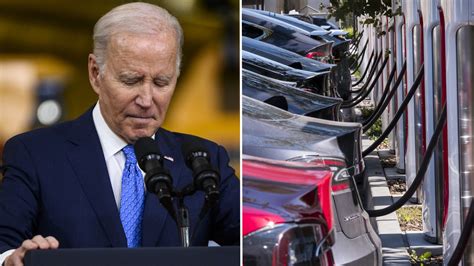By Thomas Catenacci
The Biden administration unveiled the most aggressive tailpipe emissions ever crafted as part of its sweeping climate agenda and efforts to push Americans to buy electric vehicles (EV).
The vehicle pollution standards, proposed Wednesday by the Environmental Protection Agency (EPA) and announced by the White House, will impact car model years 2027 through 2032. The White House said the regulations would “protect public health” by achieving carbon emission reductions of nearly 10 billion tons by 2055 and would save consumers an average of $12,000 over the lifetime of vehicles.
“Cars and truck manufacturers have made clear that the future of transportation is electric,” the White House stated in a fact sheet. “The market is moving.”
“As a car enthusiast and self-proclaimed car guy, President Biden is seizing the moment,” it continued. “His Investing in America agenda is expanding domestic manufacturing and accelerating adoption of zero-emission vehicles, including battery electric, plug-in hybrid electric, and fuel cell electric vehicles.”
The administration also projected the sweeping measures would “accelerate the clean vehicle transition” and reduce oil imports by 20 billion barrels. Critics have argued tougher tailpipe emissions standards for traditional gas-powered cars mainly serve to increase prices to ensure they are cost competitive with expensive electric alternatives.
Overall, if the regulations are finalized, a staggering 67% of new sedan, crossover, SUV and light truck purchases could be electric by 2032, the White House projected. In addition, up to 50% of bus and garbage truck, 35% of short-haul freight tractor and 25% of long-haul freight tractor purchases could be electric by then.
Biden previously set a goal of ensuring 50% of car purchases are electric by 2030. The White House said the rules Wednesday would provide a “clear pathway for a continued rise in EV sales.”
“The Biden administration is trying to bend every federal rule they can find to force people into buying EVs,” said Myron Ebell, the director of the Competitive Enterprise Institute’s Center for Energy and Environment. “There is still a market that allows drivers to buy the vehicles of their choice, but government coercion is rapidly limiting those choices.”
Gas-powered cars represented 93% of all new car sales in 2022, according to a recent report from the Alliance for Automotive Innovation. And EVs remain far more expensive and less efficient than alternatives.
Overall, the average cost of an EV was $64,338 while the average cost of a compact gas-powered car was $26,101 as of last year, according to Kelley Blue Book. In addition, the Department of Energy reported that the average range of model year 2021 gasoline vehicles was 403 miles compared to the median 234-mile range of model year 2021 EVs.
And Republican lawmakers also blasted the rule after it was first reported by various news outlets last week.
“Yet another draconian rule from the Biden Admin,” Rep. Dan Newhouse, R-Wash., said. “From gas stoves to vehicles, their anti-American energy policies put our nation on a dangerous path. It’s time for the government to stop over-regulating our lives and protect our energy independence.”
“Biden’s radical EPA is trying to regulate your car’s engine into OBLIVION. Enough energy fantasies,” Rep. Chip Roy, R-Texas, tweeted. “[The House GOP] MUST use the power of the purse to END the weaponization of the federal bureaucracy. Slashing EPA’s funding should be at the top of the list.
In August 2021, President Biden signed an executive order, requiring the EPA to introduce fuel efficiency and emissions standards to “tackle the climate crisis.” Months later, in a move reversing a Trump administration rule, the EPA finalized greenhouse gas emissions standards for vehicles made between 2023 and 2026, regulations the agency billed at the time as the “most ambitious” rules of their kind.


ONE ELECTRIC CAR BATTERY
500 Tons of Ore to refine 25 lbs. of Lithium
900 to 1000 gal. of fuel to move the ore
Lithium is refined by using sulfuric acid.
The mine at Thacker Pass requires 75 semi loads of acid a day.
One electric battery for a Tesla requires
25 lbs of Lithium
6o lbs of nickle
44 lbs of Manganese
30 Ibs of Cobalt
200 Ibs of Copper
400 lbs of Aluminum, Steel and Plastic
To produce one battery takes tremendous amounts of energy supplied by coal, nuclear or gas fired power plants.
If you believe this is Green Energy, then we are all in trouble.
The next President will over rule this EO.